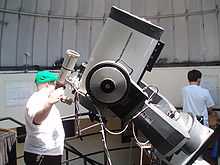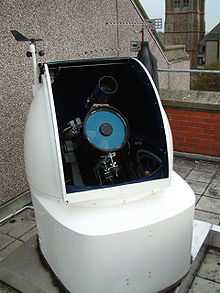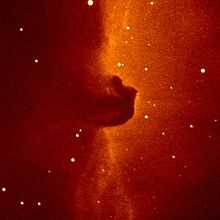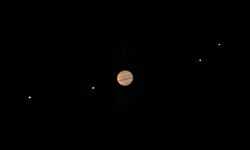Meade LX200




The Meade LX200 is a family of commercial telescopes produced by Meade Instruments launched in 1992 with 8″ (20 cm) and 10″ (25 cm) Schmidt–Cassegrain models on computerized mounts.[1][2] 12" (30 cm) and 16" (40 cm) models quickly followed. It became the best-selling serious amateur telescope.[2] The original version was later informally named the "classic" LX200 as newer upgraded versions replaced it.[3] The first of these was the LX200GPS, which featured global positioning system electronics.[3] A 14" LX200GPS was later added to the line.
The advantage of the LX200 was price for its performance, which was accomplished by using electronics and software to equal the pointing performance of more expensive systems.[2] Software and optical encoders corrected for errors, and the telescope also came with auto-guiding CCD and planetarium software.[2]
A related series starting about 2008 was the even higher end RCX400 (later renamed LX400-ACF), with new optics and a motorized focus/collimation system, and with upgraded fork mount electronics. These were available in the same 8 in. (20 cm) to 16 in. (40 cm) size range on the new fork mount, and the 16" (40 cm) optical tube assembly, along with a new 20 in. (50 cm) optical tube, were available on a new German equatorial mount. These were all f/8 optical systems, costing up to 50 thousand USD for the 20" on the German equatorial mount.[4]
An f/10 version of the new optics later replaced the optics of the existing LX200GPS fork mount models, with the new product line now called the LX200R (later renamed LX200-ACF).[3] The revised optics are called advanced coma free (ACF) after a lawsuit disallowed implying that they were based on Ritchey–Chrétien optics.
In September 2012, an amateur astronomer used a LX200GPS to record an impact on the planet Jupiter.[5]
Installations
Selected observatories with LX200 telescopes.
- Mount Wilson Observatory (prototype version)
- Ball State University Observatory
- Barus & Holley Observatory
- Bayfordbury Observatory
- Bradstreet Observatory
- Clavius Observatory, Universidad IberoAmericana, Mexico City, Mexico, www.clavius.astro.org.mx
- Collins Observatory at Salem State University
- Dodge City Community College
- David Cole Observatory
- Frosty Drew Observatory
- Givatayim Observatory
- Junk Bond Observatory
- Letchworth & District Astronomical Society
- Mead Observatory
- AMJOCH Observatory at Michigan Technological University
- Mount Albert Grammar School Observatory
- Northumberland Astronomical Society
- Nyrölä Observatory
- Observatoire des Sciences de l'Univers de Grenoble
- Observatorio Astronómico de Mallorca
- Observatório Astronômico da UESC
- Perth Observatory
- Project Galileo
- Red Barn Observatory
- Science Education Observatory, Seoul National University, Seoul, South Korea
- Shattuck Observatory
- La Société Vaudoise des Sciences Naturelles - Lausanne, Switzerland
- Starkenburg Observatory
- Telus World of Science (Edmonton)
- TUBITAK National Observatory
- Van Vleck Observatory
- West Yorkshire Astronomical Society
- Widener University Observatory
- Yale Student Observatory
- York University Observatory
- Astronomical centre Rijeka
- Saint Joseph Catholic School Student Observatory, Madison, Mississippi, USA
- Harold E. Taylor Observatory at the Richard Stockton State College of New Jersey
References
- ↑ Rod Mollise - The Past, Present and Future of the Schmidt Cassegrain Telescope (ALCON 2003/Nashville), Power Point (.ppt)
- ↑ 2.0 2.1 2.2 2.3 Martin Mobberley - The new amateur astronomer - Page 34, Google Books 2010
- ↑ 3.0 3.1 3.2 Lawrence Harris - So You Want a Meade LX Telescope! (2010) - Page 17, Google Books 2010
- ↑ Durango Skies - LX400-ACF 20" (f/8) w/UHTC on MAX Mount w/Tripod
- ↑ A Fresh Impact on Jupiter